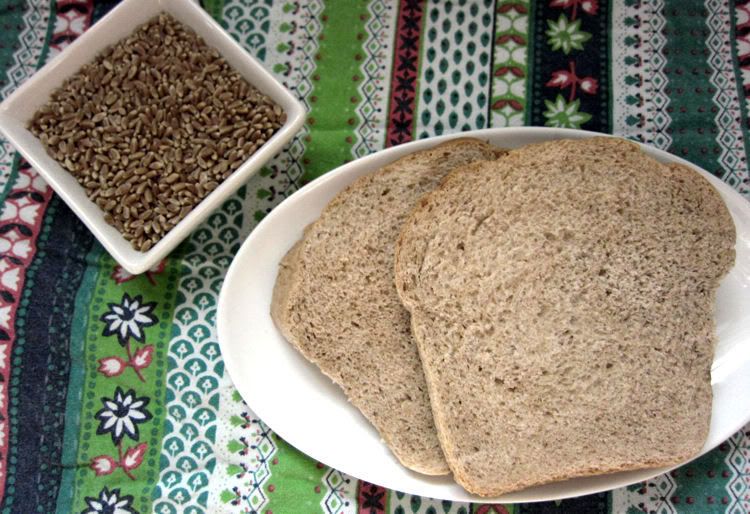
Making bread has become a regular part of my weekly routine, pulling together the most ordinary of ingredients and pulling out a loaf of bread when the oven’s done its magic.
I guess it’s almost been two years now that I’ve been making my own sandwich bread, something that is no little feat given the fact that when my husband and I were first married, I hated to cook! Fortunately, though, baking bread really is not as hard as you might think, especially if you take advantage of using a bread machine, like I do. (You can check out some of my favorite cooking and baking essentials here.)
But lately, I’ve taken my bread-making to a new level: I recently started milling my own flour. The biggest perk to milling your own flour is that in doing so, you’re preserving more of the grain nutrients that start breaking down as soon as the wheat berries get milled. If you can use fresh-milled grain (rather than flour that’s been sitting on a store shelf), then you get to put more of those nutrients in your body and reap the health benefits.
By the way, this is what wheat berries look like, before they're ground into flour (kind of similar to rice):
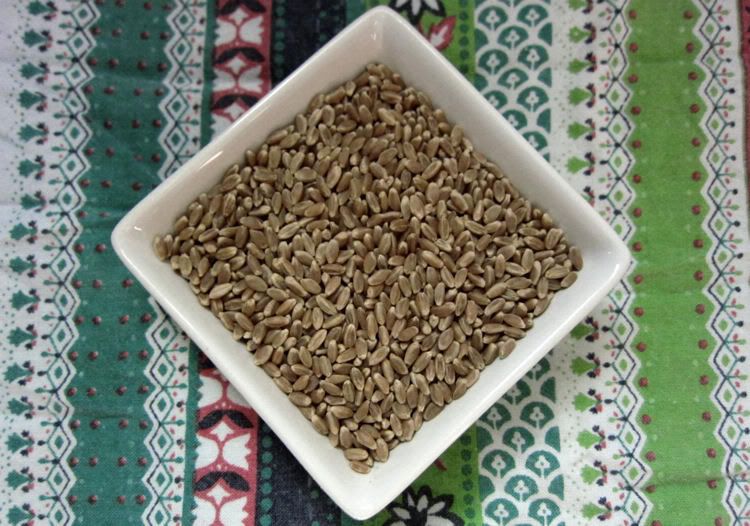
I loved the idea of getting even more from my bread making. But I was also really intimidated by the idea of milling my own wheat flour and how doing so would affect all the bread-making recipes that I already use and love. Would I have to scrap them and find new recipes? Could I really bake with 100% whole wheat without having to add in all-purpose to keep the baked goods from going dense and bland?
Thanks to the WonderMill Electric Grain Mill that I received as a participant in the The Grain Mill Wagon, I’ve had the chance to put all those questions and fears to the test. And I’m here to tell you that it is so easy and so simple to implement into your bread-making routine!
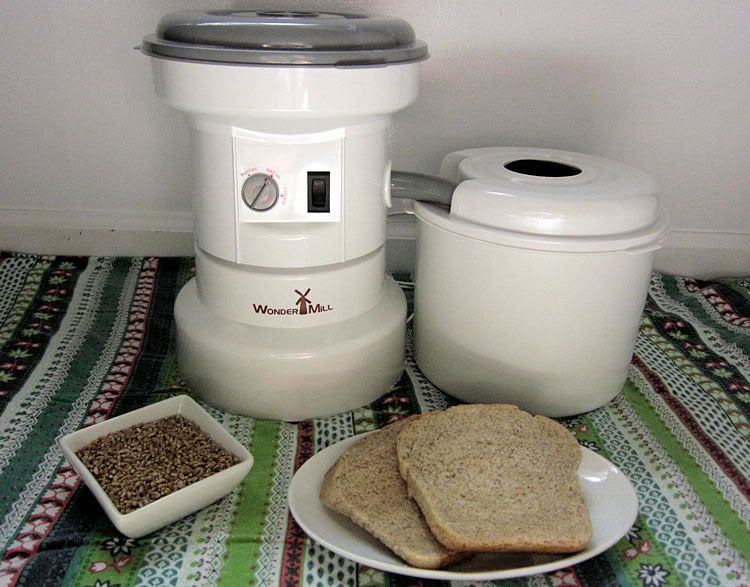
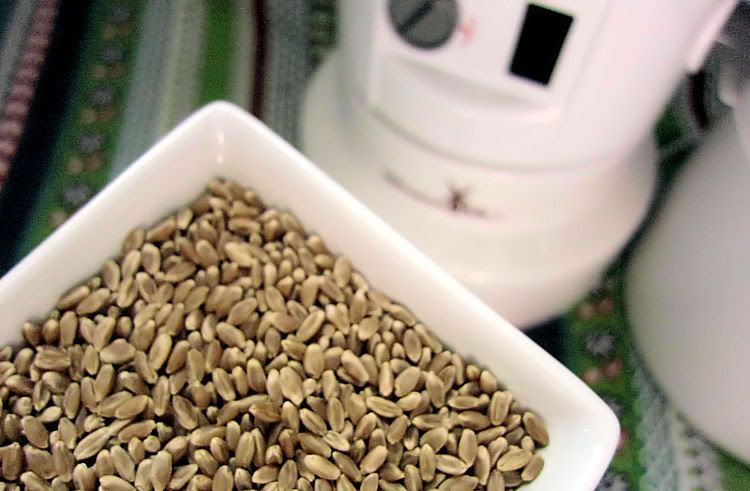
For my foray into baking with freshly milled flour, I decided to try my tried-and-true whole wheat sandwich bread recipe. Upon the recommendation of the worker at the local bread-making store where I bought my wheat berries, I decided to start off using a 1:3 combination of hard red to hard white wheat berries. The hard red is supposed to be healthier but can have a strong flavor, which is why she recommended mixing it with the milder-tasting hard white.
Once you have your berries (which look a little like rice), all you have to do is plug in the WonderMill grain mill, pour in your wheat berries, and within less than a minute, you have fresh flour, just like this:
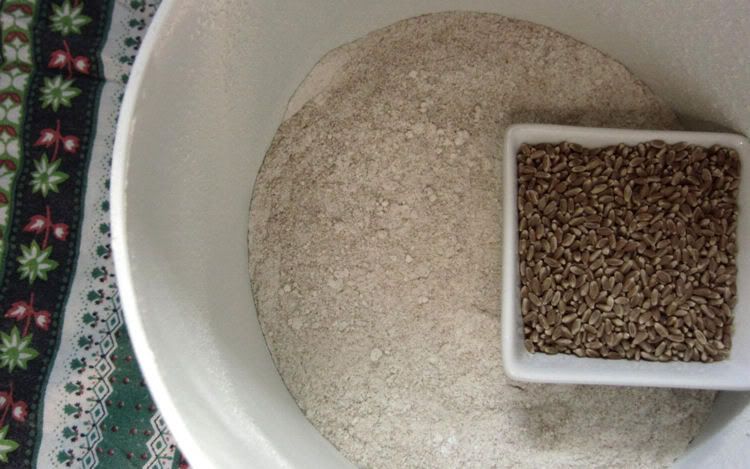
The WonderMill is no louder than my food processor and it’s not messy at all. Plus, when I was at a local bread-making shop buying my wheat berries, I overheard one of the workers telling another customer about the different grain mills that they sell, and she said that they recommend the WonderMill because it’s faster and quieter than competing brands, which cost just as much.
Then, you just swap your freshly milled flour in place of what you’d normally use and proceed as usual to get a loaf of bread that is about as fresh as you can get! I was impressed by how easy it was to substitute 100% freshly milled wheat flour for the wheat-and-bread-flour mix that I’d been using. It’s the first time I’ve been able to make a soft, springy loaf of bread using 100% wheat! And it tasted just as good as every other fresh-from-the-oven loaf I’ve made, too!
Here’s the recipe I used to make my sandwich bread using freshly milled wheat flour and a bread machine. (And, if you don’t have a grain mill, you can always reference the original recipe for my sandwich bread here.)
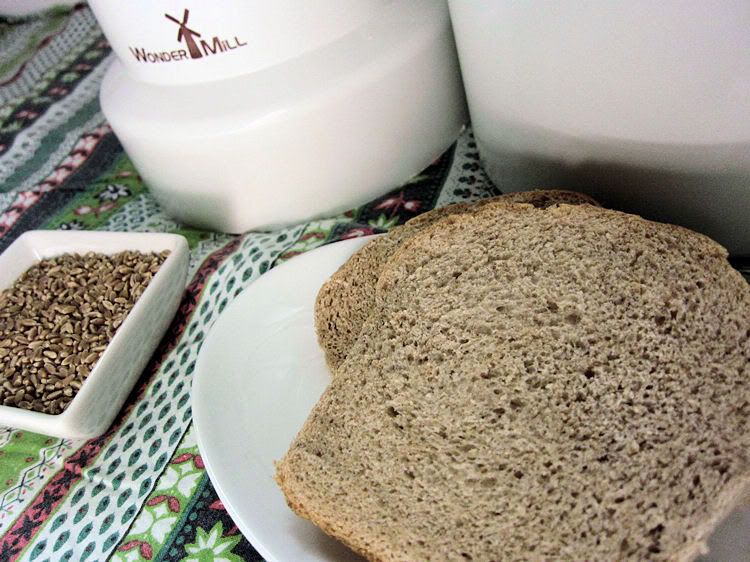
Recipe: 100% Whole Wheat Sandwich Bread using Freshly Milled Flour
⅔ cup hard red wheat berries
1⅓ cup hard white wheat berries
Grind the wheat berries in your grain mill of choice (I use the electric WonderMill Grain Mill) to a fine flour, suitable for bread-making.
⅝ cup lukewarm water
⅜ cup milk
1 egg
1½ tablespoons canola oil
1½ tablespoons honey
1½ teaspoons salt
Freshly milled flour (the 2 cups of grains will now be about 3 cups worth of flour)
2 teaspoons bread machine yeast
In your bread machine (mine is similar to this one), add ingredients from the water through the flour, adding them in the order given above. (Meaning, pour your water in first, then your milk, etc.) Once you've added the last of the flour, use a spoon to hollow out a little dent in the middle of the flour. Into this, add your yeast.
Program your bread machine on the "Dough" cycle. Press Start. Let the bread machine mix the dough and go through the rising cycle. At the end, it will beep.
Prep a loaf pan by spraying it with non-stick spray. Remove the ball of dough from the bread machine's pan, and put into the loaf pan. Press it down a bit so that it flattens to fit the shape of the dish. Put a cotton dish towel over the dish, and set in a warm place to rise for an hour. After an hour, it should have about doubled in size. (For an easy way to let your bread rise, read my breadmaking tips and tricks article.)
Turn your oven on to bake at 350-degrees. Remove the dish towel from the dough, and let it bake in the oven for about 20 to 25 minutes, until golden. Remove from oven and let cool.
Once cool, cut into slices using a good-quality bread knife. (This is the bread knife I use and recommend.) Store slices in a sealed bag or airtight container for up to a week. (In hot weather, I'd recommend keeping the loaf in the fridge to keep it from going moldy too quickly.) Recipe makes one medium-sized loaf of wheat bread.
Related Posts
Homemade Breadmaking Tips & Tricks
A Love-Hate Relationship with My Bread Maker





This is so cool! I'm very impressed :)
ReplyDeleteThanks! It's actually a lot easier than I'd expected, so I was thrilled :)
DeleteWelcome to the world of grinding your wheat! I've been milling for a few years and always feel very home-makery when I do. I started out with a bread machine looong ago, then stopped making bread because my growing family ate it so fast I couldn't keep up and finally moved to my beloved Bosch heavy duty mixer. I make five loaves at a time, keeping one out to eat right away and freezing the other four. They thaw quickly and smell and taste just as good as when they came out of the oven. There you go, now you know more about a stranger's bread making than you ever wanted to.
ReplyDeleteThanks, Elizabeth! I have really enjoyed making my own bread and am so glad to be able to grind my own flour now. I'm really looking forward to reaping the nutritional benefits of it! (And I always have a loaf ready and waiting in the freezer, too! You're exactly right that you can't tell a difference at all!)
DeleteHow cost effective is it compared to what you buy at the store? I have been making all of our bread for about a year and a half, but I don't buy expensive flour, just the stuff at the store. I've heard of people milling it themselves, but if it's not cost effective I can't afford to do it. If it is, maybe I'll start asking for a mill for my birthday!
ReplyDeleteWell, it really depends on the price of your wheat berries. I went to a local breadmaking store and they were about $35 for 45 lbs of organic red wheat berries, so a tad more expensive for me than if I were to just buy a 5lb. bag of store-brand wheat flour. However, you should know that a 45 lb. bag of wheat berries will make 60 lbs. of flour. So factor that into doing your calculations. I have heard that some people are able to buy in bulk and find wheat berries for $25 for 40-50lbs. and if you can do that, it becomes much cheaper than buying from the store.
DeleteFor me though, even if I pay a little bit more, the health benefits that come with it are worth it. It's not substantially more (once you've got your grain mill), so it's a slight price I'm willing to pay. I am going to keep looking around and try to find more inexpensive options next time I need to buy more grain (although with two 45lb. bags, it'll be awhile!)
Let me know if you have any other questions.
First of all - amazing food photography!! Second, I am so jealous of your mill! I didn't even know it was possible to mill your own flour at home - this is definitely something I will be looking into more. I checked out their website - did you know you can make bean flours too? Hello protein!!
ReplyDeleteThanks, so much! I think the secret to decent food photography is finding good light. I had to take those photos on my bedroom floor :)
DeleteYes, I love being able to mill my own flour! I only found out about it about a year ago and have been wanting to give it a try ever since. I haven't tried grinding beans with it yet, but I want to; I know doing so you can make your own Ezekial bread and I recently saw a recipe for making super-fast refried beans by grinding up your pinto beans and then cooking them. I have plans to try that sometime soon!
Does this mill separate the bran out of the flour? I have a recipe that says to sift the bran out of the flour as it is indigestible. It seems like an awful waste?
ReplyDeleteThis mill does NOT sift out the bran; it all gets poured into the canister along with the wheat germ (another part of flour that is often removed from conventional flour). I agree with you that I think that sifting the bran out seems wasteful--and less nutritional. That's one of the perks to making your own flour! Otherwise, I think you could just buy regular flour, which already has the bran removed? Don't quote me on it, but that might be an option.
DeleteWhat is bread machine yeast? And have you ever tried with all red wheat berries? That is all whole foods has. I am new to having a bread machine and was concerned about not using "bread flour" as all the recipes suggest. Also can I cook the bread in my bread machine? Just wondering why you put it in the oven.
ReplyDeleteBread machine yeast is found in the baking section of grocery stores. Never made it with all red, but you could definitely try, I just never have. A lot of baking is made with experimentation! Also, you can cook it in your machine but mine doesn't bake a "pretty" loaf so I prefer the oven. Just depends on how your machine bakes it. Good luck!
DeleteI've been using freshly milled grain for a while now. I love seeing other bloggers who are using it. Thanks for sharing the bread recipe.
ReplyDeleteI am currently trying this for the first time :) I shall see how it turns out! I was blessed with a 50lb bag of wheat berries yesterday. :)
ReplyDeleteThis comment has been removed by the author.
ReplyDeleteI am having trouble getting my bread to rise? It seems no matter WHAT I do, what I grind, how I prepare the yeast, I CANNOT get my dough to rise! Please, help.
ReplyDeleteI haven't tried your recipe yet but plan to. My question is, do you ever have a problem with your dough rising without adding gluten?
ReplyDeleteI'm new to this milling thing, having success with my bread/yeast products but I'd like to be able to make some cookies my husband will eat. suggestions anyone? do i just use more leavening? they dont rise like i want them to and hes not big on oatmeal cookies.
ReplyDeleteisn't it a pity though to go that far for a healthier diet and stop just before using home made wild yeast (sourdough) that will make your beautiful flour digestable by getting rid of the phytic acid that prevents us to digest minerals from grains ... so if you are using whole wheat flour without sourdough fermentation most of the minerals are bound together and therefore not digestable by our human body + the new hybrid wheat berries (since the 50') are made with huge gluten structure (for bakers machinery and people allergies (!)) whereas the ancient grains (kamut, einkorn, emmer, Sonora whole white wheat and all the old species of your region) are much lower in gluten (smaller too) and much better for our health and with handmade bread and sourdough they become (or become again as prior the 50') of bread making quality ... (sorry for the broken English!!)
ReplyDelete